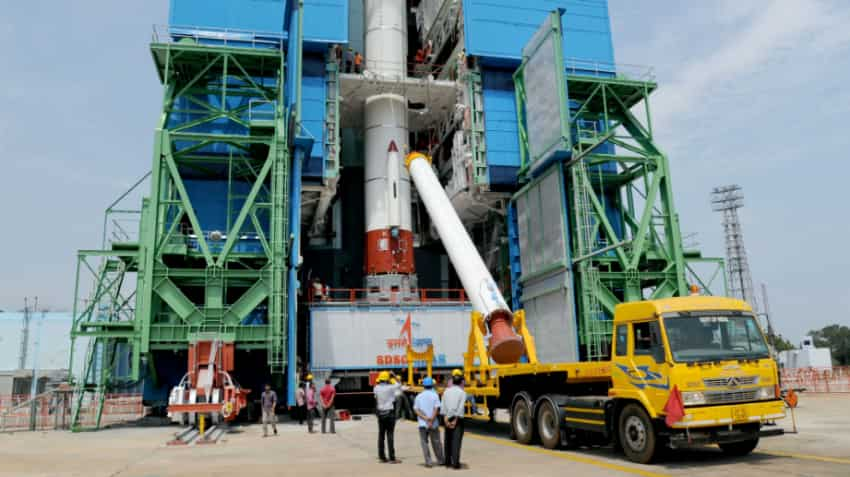ISRO to launch another satellite tomorrow; here are more details
ISRO will be launching India’s Polar Satellite Launch Vehicle in its forty-third flight (PSLV-C41).

The government’s space agency, ISRO, will once again be attempting another satellite launch, right within two weeks of the previous GSAT 6A satellite’s failure. The agency, which was recently criticized for loss of GSAT 6A despite making a successful take-off, has shrugged off uncertainty and plans to touch new milestone with new satellite launch. ISRO will be launching India’s Polar Satellite Launch Vehicle, in its forty-third flight (PSLV-C41).
On its official twitter account, ISRO said, “The 32 hr countdown activity has commenced at 20:04hr IST on Tuesday, April 10, 2018 for the launch of PSLV-C41/IRNSS-1I Mission scheduled at 04:04 hr IST on April 12, 2018.”
PSLV-C41/IRNSS-1I Mission
The 32 hr countdown activity has commenced at 20:04hr IST on Tuesday, April 10, 2018 for the launch of PSLV-C41/IRNSS-1I Mission scheduled at 04:04 hr IST on April 12, 2018https://t.co/vcsnP2WSoo— ISRO (@isro) April 11, 2018
Live telecast of the new satellite will be done on Doordarshan, and webcast will be available on ISRO website on Thursday, from 3:30 hours (IST) onwards.
PSLV-C41/IRNSS-1I Missionhttps://t.co/vcsnP2WSoo pic.twitter.com/pO7tXMhxlR
— ISRO (@isro) April 11, 2018
The 43rd PLSV-C41 in XL configuration will also launch RNSS-1I Satellite from First Launch Pad (FLP) of SDSC SHAR, Sriharikota.
The 'XL' configuration of PSLV is used for the twentieth time. The IRNSS-1I is the eighth satellite to join the NavIC navigation satellite constellation.
Here are key features of IRNSS-1I
IRNSS-1I is the eighth navigation satellite to join the IRNSS space segment.
Its predecessors, IRNSS-1A, 1B, 1C, 1D, 1E, 1F and 1G were launched by PSLV-C22, PSLV-C24, PSLV-C26, PSLV-C27, PSLV-C31, PSLV-C32 and PSLV-C33 in July 2013, April 2014, October 2014, March 2015, January 2016, March 2016 and April 2016 respectively.
Like all other IRNSS satellites, IRNSS-1I also has a lift-off mass of 1425 kg. The configuration of IRNSS-1I is similar to IRNSS-1A, 1B, 1C, 1D, 1E, 1F and 1G.
Just like other IRNSS predecessors, IRNSS-1I also carries two types of payloads – navigation payload and ranging payload.
Navigation payload of IRNSS-1I transmits signals for the determination of position, velocity and time. It operates in L5-band and S-band. Also, Rubidium atomic clocks are part of the navigation payload of the satellite.
Meanwhile, ranging payload of IRNSS-1I consists of a C-band transponder, which facilitates accurate determination of the range of the satellite. It also carries Corner Cube Retro Reflectors for LASER Ranging.
This new launch comes after when, ISRO is scrambled in explaining the failure of the previous GSAT 6A satellite.
Sources in ISRO stated that a power system failure was the cause of the satellite going off the radar. The GSAT 6A satellite setback cost ISRO Rs 270 crore, said an NDTV report.
Earlier, the Comptroller and Auditor General of India (CAG), before the GSAT 6A failure occurred, had criticised the space agency for lacking behind schedule in developing ground infrastructure for its projects.
The CAG had stated that the development on ISRO’s satellite systems remained idle for 14 months, despite spending around Rs 1,283 crores.
Get Latest Business News, Stock Market Updates and Videos; Check your tax outgo through Income Tax Calculator and save money through our Personal Finance coverage. Check Business Breaking News Live on Zee Business Twitter and Facebook. Subscribe on YouTube.
RECOMMENDED STORIES

EPFO Pension Schemes: Early pension, retirement pension, nominee pension and 4 other pension schemes that every private sector employee should know

Tata Motors, Muthoot Finance and 3 more: Axis Direct recommends buying these stocks for 2 weeks; check targets, stop losses
01:52 PM IST











 Scanpoint Geomatics enables its GIS Based mobile application 'Survey 360' - Check
Scanpoint Geomatics enables its GIS Based mobile application 'Survey 360' - Check  Cabinet approves new moon mission Chandrayaan-4
Cabinet approves new moon mission Chandrayaan-4  ISRO to launch earth observation satellite on Friday
ISRO to launch earth observation satellite on Friday  ISRO set to launch Earth Observation Satellite-8 from Sriharikota on August 15
ISRO set to launch Earth Observation Satellite-8 from Sriharikota on August 15 ISRO's Aditya-L1 completes first halo orbit around Sun-Earth L1 point
ISRO's Aditya-L1 completes first halo orbit around Sun-Earth L1 point